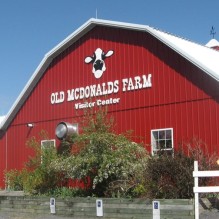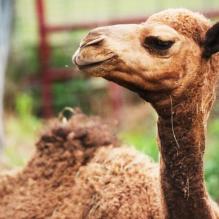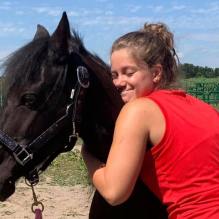NATURE PLACE JOURNAL: A WALKING ADVENTURE IN THE ADIRONDACKS (November 2021) by Carolyn M Johnson
November, “the month that hangs on the cusp of autumn and winter” (as said in a recent Adirondack Almanac), makes me ponder what experiences may attract my attention and my family’s.
November 17th is National Hiking Day. What type of hiking might I consider doing? Easy walking trails, hiding among more daring ones, abound in northern New York on the Adirondack wilderness’ southwest edge. So, I would choose Cranberry Lake, New York, the Adirondacks’ third largest lake, about two hours from Lowville, New York.
Cranberry Lake was so named because a great cranberry bog once thrived in the area. It seems appropriate to think about it at this time of year because cranberries are a staple of the Thanksgiving meal. In areas that are part of the Adirondacks’ Cranberry Lake 50 trail system, travelers can find tiny hamlets of civilization featuring quaint little shops and roadside displays, and access to trail-heads lead to forest walks, hikes, snowshoeing, and easy cross-country skiing.
My walking adventure in the area would feature breathing in the fresh crisp country air and meandering about walking trails. I’d be on the lookout to photograph captivating scenery, including the various hues of autumn trees, sparkling snow-patches, and rippling waters. I’d look for wild flora including white pine, hemlock, birch and maple trees, ferns, carnivorous plants, and colorful mushrooms. If I’m lucky, being quiet and observant, I may catch sight of coyote, fox, black bear, bobcat, otter, fisher, marten, deer, moose and many more. Birds of this area include bald eagles, osprey, great blue herons, kingfishers, turkey vultures, loons, turkey, ruffed grouse, red-tailed hawks, barred owls, great-horned owls, ducks, geese, and many others, including a host of migratory and year-round songbird species.
Wanekena, featuring a Cranberry Lake 50 Trail marker, is called the gateway to the Adirondack wilderness. It’s recommended beginning at Wanekena and walking clockwise; maybe beginning at a wooden foot bridge.
Oswagachie River Walk by Cranberry Lake offers picturesque viewing experiences on a bridge.
Readway Ponds Trail near Star Lake, New York is an easily accessible nice walk or gentle snowshoe hike/easy ski in the woods with interesting rolling hills. The trail goes between two ponds, then onward to a river featuring attractive waterfalls.
A nature trail near Fine, New York features a one-quarter-mile trail going to an observation platform overlooking wetlands and a waterway called Greenwood Creek.
There are also the kid-friendly, easy hike/nature-walk areas that are 1.7 and 2 miles, called Cranberry Lake Red, Purple, and Yellow Loop; and Cranberry Lake Quarry Loop; both near West Harrison, New York.
On a short Lost Pond Trail near Cranberry Lake find wildlife and wetland plants.
Suzanne Kindler’s poem Up North, at Facebook’s An Adirondack Community captures the essence of what a trail experience can be, with lines including: “It’s no mystery where the north woods start when you arrive up North you’ll knowin your heart.”
(c) NATURE PLACE JOURNAL, November 2021
NATURE PLACE JOURNAL: A WALKING ADVENTURE IN THE ADIRONDACKS (November 2021) by Carolyn M Johnson
November, “the month that hangs on the cusp of autumn and winter” (as said in a recent Adirondack Almanac), makes me ponder what experiences may attract my attention and my family’s.
November 17th is National Hiking Day. What type of hiking might I consider doing? Easy walking trails, hiding among more daring ones, abound in northern New York on the Adirondack wilderness’ southwest edge. So, I would choose Cranberry Lake, New York, the Adirondacks’ third largest lake, about two hours from Lowville, New York.
Cranberry Lake was so named because a great cranberry bog once thrived in the area. It seems appropriate to think about it at this time of year because cranberries are a staple of the Thanksgiving meal. In areas that are part of the Adirondacks’ Cranberry Lake 50 trail system, travelers can find tiny hamlets of civilization featuring quaint little shops and roadside displays, and access to trail-heads lead to forest walks, hikes, snowshoeing, and easy cross-country skiing.
My walking adventure in the area would feature breathing in the fresh crisp country air and meandering about walking trails. I’d be on the lookout to photograph captivating scenery, including the various hues of autumn trees, sparkling snow-patches, and rippling waters. I’d look for wild flora including white pine, hemlock, birch and maple trees, ferns, carnivorous plants, and colorful mushrooms. If I’m lucky, being quiet and observant, I may catch sight of coyote, fox, black bear, bobcat, otter, fisher, marten, deer, moose and many more. Birds of this area include bald eagles, osprey, great blue herons, kingfishers, turkey vultures, loons, turkey, ruffed grouse, red-tailed hawks, barred owls, great-horned owls, ducks, geese, and many others, including a host of migratory and year-round songbird species.
Wanekena, featuring a Cranberry Lake 50 Trail marker, is called the gateway to the Adirondack wilderness. It’s recommended beginning at Wanekena and walking clockwise; maybe beginning at a wooden foot bridge.
Oswagachie River Walk by Cranberry Lake offers picturesque viewing experiences on a bridge.
Readway Ponds Trail near Star Lake, New York is an easily accessible nice walk or gentle snowshoe hike/easy ski in the woods with interesting rolling hills. The trail goes between two ponds, then onward to a river featuring attractive waterfalls.
A nature trail near Fine, New York features a one-quarter-mile trail going to an observation platform overlooking wetlands and a waterway called Greenwood Creek.
There are also the kid-friendly, easy hike/nature-walk areas that are 1.7 and 2 miles, called Cranberry Lake Red, Purple, and Yellow Loop; and Cranberry Lake Quarry Loop; both near West Harrison, New York.
On a short Lost Pond Trail near Cranberry Lake find wildlife and wetland plants.
Suzanne Kindler’s poem Up North, at Facebook’s An Adirondack Community captures the essence of what a trail experience can be, with lines including: “It’s no mystery where the north woods start when you arrive up North you’ll knowin your heart.”
(c) NATURE PLACE JOURNAL, November 2021
Writing Prompts to Inspire
prompts previously posted elsewhere:
Which poems or stories would you like most to introduce a new young family member to? (2020 11 06)
Essential Things to Note 2020+ (find Oasis Spots in A Desert!)
When a place that’s known as the North Country is called trump country, it is of the utmost importance to find oasis spots in such a desert!






OF KAUAI HAWAII AND OTHER HAWAIIAN ISLANDS – TALES AND TRADITIONS FOR MIDDLE GRADE READERS at FROM THE MIXED UP FILES OF MIDDLE GRADE AUTHORS (Oct 2020)
of my middle grade mystery novel (subtitled: “A Millennium Era Mystery”) – its journey toward publication
Possible main titles:
In the Forest, Through the Mist, and Beyond…
On the Cusp
More Information at my Facebook page about this novel: url to come
An Old MacDonald’s Farm, in Sacketts Harbor NY – Sept ’20
An article by Carolyn M Johnson in NATURE PLACE JOURNAL (September 2020)
There’s actually a place in Sacket’s Harbor, New York, near Lake Ontario, that’s called Old McDonald’s Farm.

Within the boundaries of this working agricultural and dairy farm, a multi-generational family allows cows, goats, pigs, horses, donkeys, chickens, rabbits, alpacas, peacocks, and even reindeer to roam.

The “farmer’s wife” and matriarch, Nancy Robbins, wanting to help the family’s income while caring for her children, started Old McDonald’s Farm in 1977.
Raised in the nearby small city of Watertown, New York, she eagerly shared the lifestyle of a dairy farmer with the nearby urban community of Sacket’s Harbor.
Here, humans can interact with their animal neighbors, experiencing hands-on meet-and-greets while petting, feeding, hugging, and walking in the midst of them.

Guided hay-walks introduce excited young visitors and marveling adults to more than 200 animals. It’s endearing to witness squeals of delight from young visitors as they exclaim “I petted a pony!” Or “I touched a goat!” Parents interact with toddlers, saying, “Look, there’s a cow! What does she say?” and a child responds, “MOO!” Then there are us adult visitors smiling with amusement at nature’s marvels.

Along with the hay-walks, tours of the family’s nearby North Harbor Dairy—called fun even while learning—are by reservation for limited private groups. The North Harbor Dairy Farm, now run by the fifth generation of family members, features a fascinating tour for all, with a state-of-the-art calf barn, a heifer barn, and a 1000-cow free-stall dairy barn. There’s also a round-the-clock modern milking parlor. Visitors can discover how calves are raised and watch as many as 100 calves—some only a day old—drink from robotic feeders. Computer technology records and reveals a cow’s daily production of milk, her food and nutritional intake, plus her breeding and delivery dates.
Questions are welcomed on how the farm contributes to local communities’ food supply.
Freshly-prepared milk, homegrown strawberries, sweet corn, and other seasonal vegetables, are for sale, and at the Lazy Cow Café, visitors can enjoy a variety of homemade ice-cream flavors.
With daily pig races, a mini-golf course, goat yoga, and a corn maze that honors the nearby Fort Drum, there are activities for any age.
Soon, fall will arrive, along with pony rides, hay wagon rides, exploring activities in a high corn field, and a pumpkin patch.
Although started out of a desire to help feed her family, the farmer’s wife has indeed created a farming haven for locals and visitors alike.
Thanks to Old McDonald’s websites for photos.
(c) September 2020 reproduced by permission of editor of Nature Place Journal
A Re-Write of An Old Poem with Some Altered Lines that Seem to Speak to the World of 2020
Place on thy country’s brow the weeping willow…
Pestilential vapors soon shall dry
each shrub that buds around…
… the yellow plague infest the air;
… noxious vapors blight the turf…
But wait…
[Don’t] float… along the current as [it] may,
[with just a] humble tribute of a tear to pay…
[Oh try] to turn the mighty tide of song…
[Some can] choose another theme…
…If the wild winds of thy western lake
might teach a harp…
and sweep those strings…
or give an echo…
the… chord would not be swept [away] in vain;
… there are spirits here, that to the strain
would send a still small voice responsive back again…
That isle afar [ought to] be blest
for the fresh breezes of [our] native west…
[all] should seek…!
It may not be… [and yet]…[it must]…
Don’t let the hand too feeble be…,
too weak and frail the harp, the lay too brief
to speak the sorrows of a mourning land…
[Oh let there be] a heart-felt sigh… that’s more than just a sob of woe…; let it be more a gasp of hope that grows…
[Note: lines adapted from parts of the poem ___________ by _________________]
[Note also: the isle, and the native west, could be seen as referring to the state of Hawaii, its friendly breezes and Aloha way of life — all represented in Congresswoman Tulsi Gabbard who, in an ideal world for “we the people” could be president some day soon, and a major part of a President Bernie Sanders administration in the White House]
Contents Pages for Classic Literature for Young Adults in a volume of Discovering English Literature in Bits & Bytes: An Internet Approach
Selections From Classic Literature For Young Adults – Contents Pages
01. “Alice’s Adventures Under Ground” Chapter One (first copy) by Lewis Carroll (pen name of Charles L. Dodgson) (1862) (1865)
02. “I had now the key…” (chapter vi in “The Story of My Life“), “Three Days To See,” “Letter On Beethoven’s 9th Symphony,” “Letter to Mark Twain,” “How to Become A Writer,” and more, by Helen Keller (1897-1968)
03. Excerpts from “The New Chronicles Of Rebecca” (e.g., “Third Chronicle: Her Thought Book,” “Tenth Chronicle: Her Reminiscences“) by Kate Douglas Wiggin (1907)
04. “Nancy’s Idea” and “Gilbert’s Embassy,” and Other Excerpts From “Mother Carey’s Chickens” by Kate Douglas Wiggin (1911)
05. Excerpts from “Oh, The Places You’ll Go!,” “The Lorax,” “Horton Hears A Who” and Other Works by Seuss (Geisel, Theodor) (1932–98)
06. Quotations on Writing, “Talking Of Horses,” “The Follyfoot Series,” “World’s End,” “Messenger,” “Mariana,” and Other Selected Works by Monica Dickens-Stratton (1939–96)
07. Selected Excerpts from “Watership Down” by Richard Adams (1962)
08. Etext of Chapter One, Excerpts and Quotations in Other Chapters, from “A Wrinkle In Time” by Madeleine L’Engle (1962-2012)
09. Excerpts from “People Of Pineapple Place” and Other Fantasies, plus “The Meaning Of Life and Other Poems” by Anne Lindbergh (1974-2000)
10. Chapter One and Other Excerpts from “The Giver” by Lois Lowry (1993)
11. First Chapters from the “Mary Russell And Sherlock Holmes” Mystery Series by Laurie R. King (1994–Present)
12. Excerpts from “P.S. Longer Letter Later” and “Snail Mail No More” by Paula Danziger and Ann M. Martin (1998 and 2000)
13. Excerpts from “Who Moved My Cheese?” by Spencer Johnson (1998)
14. Excerpts from “Escape From Memory” by Margaret Peterson Haddix (2003)
15. Excerpts from “The Highest Tide” by Jim Lynch (2005) .
16. Excerpts from Mimzy Were the Borogoves
17 Introducing J.K. Rowling’s “Harry Potter”
18. The Importance of Imagination” (speech, 2008) by J.K. Rowling
19. Excerptsfrom Hans Christian Anderson Literature Prize winners… (2007+) (and before)
20.